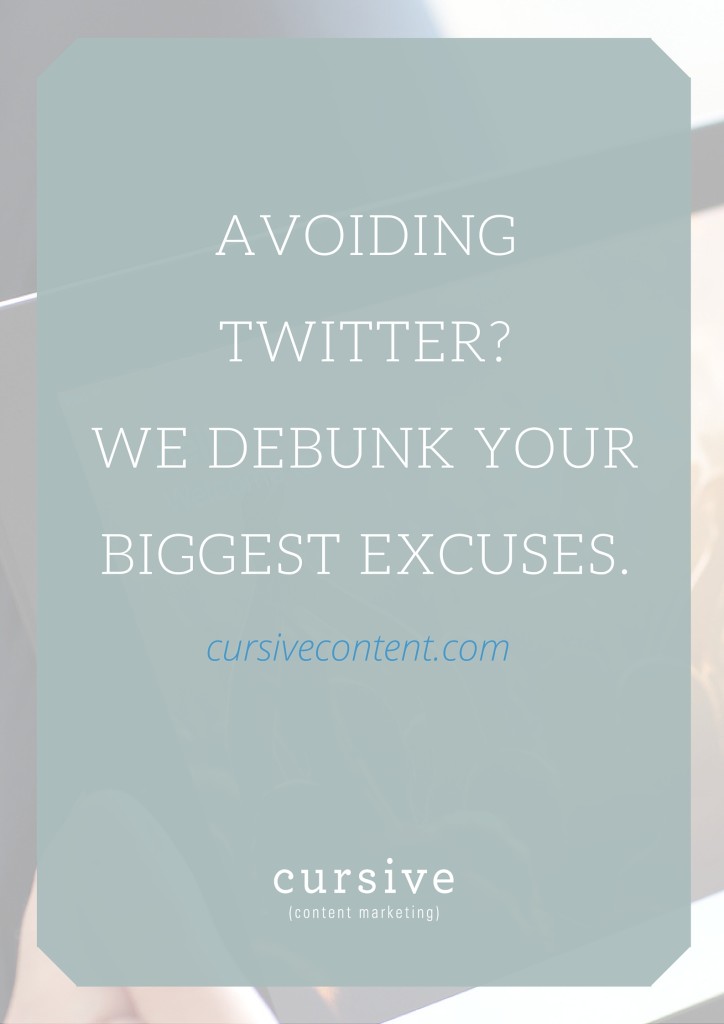Avoiding Twitter? We Debunk Your Biggest Excuses.
Of all the social networks we have ever recommended to clients, nothing meets more resistance than Twitter.
It seems the network has a reputation for being time-consuming and overwhelming, especially amongst small businesses and organizations who don’t have a dedicated social media team.
Sure, Twitter isn’t right for everyone (no social network is). But if it is a good fit, and you’re still holding back, we know the excuses you probably have lined up—and we have a few rebuttals you need to hear.

Excuse #1: “Twitter moves too fast. I can’t keep up with the number of times per day I should be posting.”
It is true that a solid Twitter presence requires a higher quantity of posts than most other networks. But you can make it manageable by using a tool like Buffer or HootSuite, which allow you to schedule posts in advance.
You should still check in on your Twitter account as often as you can (it’s still important to join the conversation), but scheduling tools allow you to get the bulk of the work done ahead of time, in between meetings and deadlines.
Excuse #2: “I don’t have enough relevant content to share. I would have to spend half my day browsing the internet to find articles to tweet.”
If you aren’t used to curating content, the idea of finding a handful of articles to share each day is overwhelming. The trick is to build up a base of reliable, relevant content sources you can turn to for information about your field or industry.
A news aggregator, like Feedly, is a great way to make this manageable, since it pulls in all of the posts from a source. When you find a website or blog you love, add it to Feedly. You can then turn to Feedly as the single place to read a variety of articles from sources you know and trust.
Feedly also provides some great ways to keep all that content organized. Two of my favorites: set up categories and add items to a “Saved for Later” list.
There is a fair amount of work involved in finding great sources and pulling them all together, but chances are you can think of at least a half dozen websites or blogs you already read; it’s just a matter of putting that content you are already consuming to another use.
Another great way to ensure great content crosses your path regularly? Sign up for enewsletters. Once you sign up and new content starts arriving in your inbox on the regular, it will be hard to remember a time when you felt you had nothing to share.
As an added bonus, all this reading will help keep you up-to-speed with what is going on in your industry. No mo’ FOMO.

Excuse #3: “Some days, it’s a struggle to keep up with my other social networks. How can I add Twitter on top of all that?”
We feel your pain. It is important to evaluate your ability to commit before jumping onto another network; if it’s truly evident that having a presence is not something you can maintain in the long-term, it might be better to wait.
If your hesitancy is caused by a vague sense of overwhelm, though, don’t get discouraged. Those other networks might actually help you with Twitter. Articles and images that you share on Facebook, Pinterest, LinkedIn, Instagram and other networks can be repurposed for use on Twitter.
This repurposing, combined with the scheduling and content aggregator tools mentioned above, makes the addition of one more network much more manageable.
Excuse #4: “I can’t check in on Twitter constantly throughout the day. I have meetings, and other work to get done…it’s just not realistic.”
Here’s the truth: everyone is busy, so everyone fails at this sometimes. Don’t let perfection be the enemy of good.
Again, technology can help significantly. Set up notification emails or enable alerts on your phone. This will ensure that you won’t miss any likes, mentions or comments. Then you can dedicate the time you do have to devote to the network by browsing your feed and creating connections with the actual people behind the Twitter handles.
If your concerns are squashed and you’re ready to tackle Twitter, check out our 20 Best Tips for Mastering Twitter for Business. Still hesitant? Leave us a comment and let us know what your worries are—we’d love to help.
MORE ARTICLES
-
 How to Support Your School Story with Organic, Authentic Social Media
How to Support Your School Story with Organic, Authentic Social Media -
 How to Attract Dream Families with Unforgettable Private School Social Media Advertising
How to Attract Dream Families with Unforgettable Private School Social Media Advertising -
 The Case for School Content Marketing
The Case for School Content Marketing -
 Social Proof: What Is It, and How Can School Marketers Use It?
Social Proof: What Is It, and How Can School Marketers Use It? -
 Conversion Copywriting for Schools: An Introduction
Conversion Copywriting for Schools: An Introduction -
 10 Questions to Help Conquer School Marketing FOMO
10 Questions to Help Conquer School Marketing FOMO -
 You Wrote a School Blog Post— Now What?
You Wrote a School Blog Post— Now What? - 2 NEW Ways to Inspire School Blog Content in 2017
Excellent article, Stacy. Twitter requires a certain amount of dedication and attention, but with the right approach and the right tools it can skyrocket your engagement. Thanks, Niraj (Founder at hiverhq.com)
Thanks, Niraj!